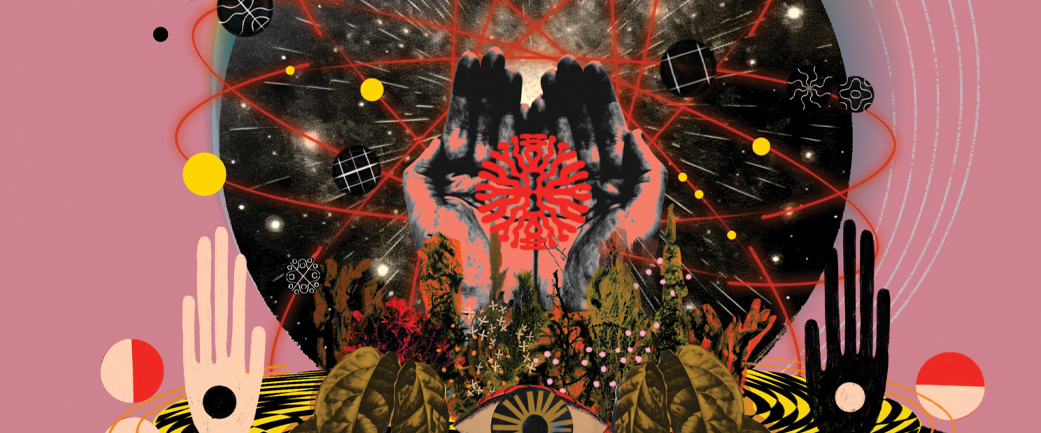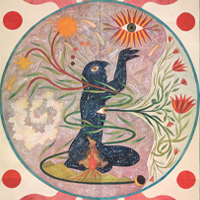
How a reorientation to one’s place in the world and across history can lead to healing
Many of us underestimate how strongly we identify with the time and place in which we live. Like a data byte in the digital current, it is hard to imagine the larger context that surrounds us. Yet events that provide a glimpse at this bigger picture, or which become shared reference points for large groups of people, tend to shape our identities in quite significant ways. Likewise, feeling disconnected from our histories can have a destabilizing effect on our lives and our mental health.
In the early 1920s, Alfred Korzybski, a Polish American scholar and founder of general semantics, introduced the twin concepts of “time-binding” and “space-binding.” Taken together, these two ideas provide a bifocal lens that clarifies how we perceive ourselves as humans and our relationship to each other and our environment. Examples at the cutting edge of psychedelic healing demonstrate the power this kind of identity building can provide, even in situations of desperation, a lesson that may apply more broadly.
Bridging Time and Space
Time-binding, as Korzybski conceived it, represents the distinctly human ability for one generation to pick up where the previous generation left off and to continue to build on what came before. This is how we develop from fire, to spear, to plow, to jet engine, to virtual reality. Involved in this is the act of transmitting information and culture in a way that transcends space. It describes how we learn from the experiments of our ancestors and draw forward the empirical wisdom of the past to apply it to the present. Time-binding doesn’t only involve technological information but also other intangible assets such as our values, philosophies, political identities, or artistic styles, which are also bound in historical time.
In contrast to time-binding, space-binding involves information that does not change much over time. Genetics are a good example. Physically each generation begins in largely the same way as the preceding ones. Any significant evolution requires hundreds of thousands of years or more of gradual change. Space-binding is present in long-standing societal traditions and mythologies, which evolve over long timelines. It can also involve transoceanic exploration or interactions with other cultures, because unlike time-bound communication, these activities result in very gradual progression. People who exhibit space-binding tendencies tend to prioritize concrete, sensory information and often have a strong connection to their immediate physical surroundings.
While these may seem like opposing forces, they are, of course, intimately intertwined. The dance between them defines the movements of human history. Time-binding provides the foundation upon which we build our future, drawing wisdom from the past to inform our present actions. Space-binding anchors us deeply in our environment and our traditions, providing the point from which we move outwards to explore the far reaches of the globe. Most major advancements in communication, from the printing press to the internet, reflect both of these concepts, bridging us in time to the knowledge of the past, as well as in space to the rest of the world.
Healing through Iboga and Ibogaine
The anthropologist James Fernandez used Korzybski’s terms time- and space-binding to describe similarities in the healing use of iboga, a powerful psychedelic plant, among both Central African pygmies and North American heroin users. His use of these ideas helps to illustrate how time- and space-binding play into healing processes.
Iboga is a shrub endemic to Gabon, a small country on the western coast of Africa that shares a border with the Congo. The plant’s roots contain ibogaine, a psychedelic compound that can launch a trip that lasts twenty-four hours or more. A growing body of anecdotal reports and clinical research suggest that it has numerous health benefits.
In the late nineteenth century, amid Gabon’s suffering at the hands of colonists and slave traders, the coastal Bantu populations came in closer contact with inland Pygmy communities, who introduced the use iboga as a ritual and healing tool. Bwiti, the spiritual practice born from this intersection, became invaluable for several Gabonese communities as armed resistances against colonists faltered. Iboga emerged as a way to practically combat the decreased fertility in the labor camps, as well as to recover the sense of spiritual and moral authority that had been granted to Europeans in the previous century. For many, the practice helped them take what they had learned from interactions with outsiders and weave it into a renewed identity.
On the other side of the world, in 1962, a young heroin user from Staten Island, New York, named Howard Lotsof ingested some ibogaine that he received from a chemist friend. After a long, grueling trip, he found it relieved the excruciating opioid withdrawal and his desire to use heroin. Since the National Institute on Drug Abuse abandoned ibogaine research in the mid-1990s, its use has grown among clinics in Mexico and elsewhere, which are largely focused on providing drug detox and other healing services. Ibogaine remains the only pharmacotherapy that can reduce physical withdrawals from opioids in that way, but it appears to provide more than just symptomatic relief.
Fernandez found the pathologies of the colonial world arose from the “diminution or loss of one’s [orientation] in time and space,” something equally visible in colonialism’s historic interruption of native cultures, as in the chronic influences of imperialism within occidental culture itself. The combined visionary effects and the healing properties of iboga and the ibogaine extracted from it served in very distinct contexts to bind individuals back into a collective identity. In Bwiti they called this returning to the “Path of Life and Death” and a reengagement with village life. In the West, this looks like reestablishing ourselves in a manageable relationship to our distinct sets of social expectations.
A Broader View on Healing
In the past few years, the clinic that I cofounded, Ambio Life Sciences, has received hundreds of US special forces veterans to our facilities in Mexico. Available treatments for “operator syndrome” have failed to grasp the complexity and variety of issues that veterans face, so many have turned to seeking psychedelic treatments outside of the United States. A recent study from Stanford University showed that thirty of our patients had remission of traumatic brain injuries derived from chronic exposure to explosions and firing high-caliber weapons. These changes are visible on fMRI scans even several days after a single treatment and appear to be further improved upon follow-up a month later. Nothing else known to medicine accomplishes this type of physiological improvement.
Among veterans who attend our program, we witness physical aspects of healing as well as a renewed sense of identity and purpose. Many assume that trauma emerges from seeing horrible things in combat, but many special forces operators don’t identify this way. In fact, much of the emotional turmoil arises upon retirement. After being so highly trained and performing at such a high level under specific conditions, the end of a career can lead to a crisis of purpose, especially in the wake of grief from the loss of friends to battle or suicide. Going through the ibogaine experience seems to help ground people in the current moment (space-binding), while also helping them to sift through what is valuable to carry forward from their past while they explore new habits and a new identity (time-binding). These treatments happen in groups, and many veterans and first responders have referred friends in need, which has helped to turn the experience into a collective reference point, something that appears to be important in the healing process.
In these examples, healing emerges through a reorientation to time and space. It calls us to look at the process of how we heal in a holistic way. As psychiatric ideas about “neurotransmitter imbalances” prove to be insufficient to describe the general malaise, we have to acknowledge that how we approach our narrative about mental health can have the unintended consequence of further alienating us by explaining away symptoms that are actually situational, and which often emerge as an inner motivator to recalibrate and make some changes. Rather than treating symptoms alone, thinking about time- and space-binding may help us to incorporate the power of art and story, the formation of shared values, and the experience of rites of passage back into our healing efforts, which could prove critical for how we approach mental health in the future.
References
Fernandez, J. W. Bwiti: An Ethnography of the Religious Imagination in Africa. Princeton, NJ: Princeton University Press, 1982.
Fernandez, J. W., and Fernandez, R. L. “Chapter 13 “Returning to the Path”: The Use of Iboga[ine] in an Equatorial African Ritual Context and the Binding of Time, Space, and Social Relationships.” The Alkaloids: Chemistry and Biology 56 (2001): 235–47.
Koryzbski, A. Time-Binding: The General Theory. Lakeville, CT: Institute of General Semantics, 1949.
About the Contributor
Jonathan Dickinson is the cofounder and CEO of Ambio Life Sciences, which operates ibogaine clinics for addiction, traumatic brain injury, and other treatments. He is also initiated into Dissoumba/Fang and Ngonde Missoko branches of Bwiti in Gabon. Learn more at https://ambio.life.
Image Credit
Victoria Topping is a multimedia artist from the United Kingdom. Her color-saturated, psychedelic, heavily layered collages are inspired by music, flora and fauna, and retro ephemera, but the golden thread that binds all of her work together is a sense of unadulterated joy. @victoriatoppingstudio





